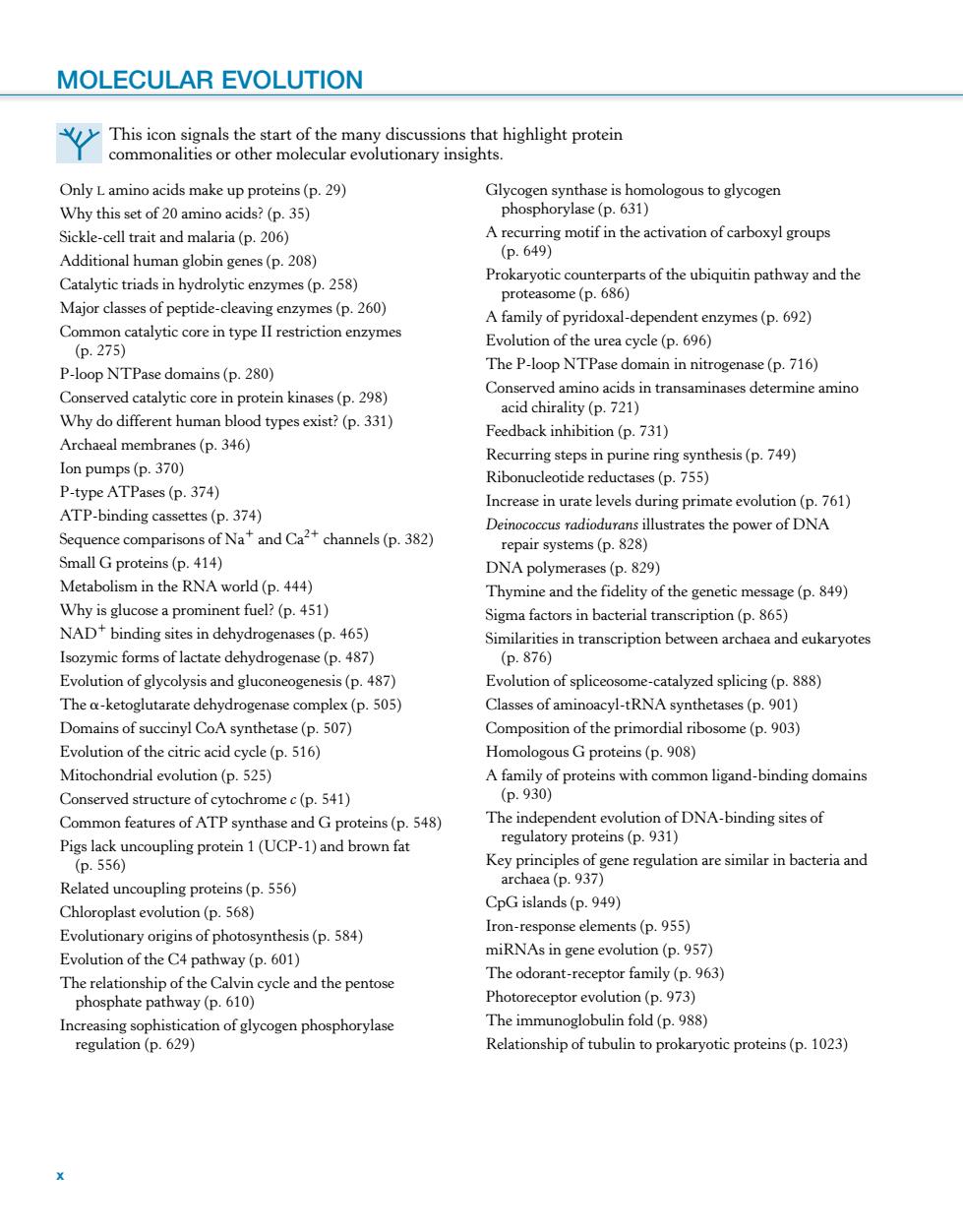正在加载图片...

MOLECULAR EVOLUTION es or other mo r evolutionary insights Only Lamino acids make up proteins(p.29) Glycogen synthase is homologous to glycogen Why this set of 20 amino acids?(p.35) phosphorylase(p.631) Sickle-cell trait and malaria(p.206 A recurring motif in the activation of carboxyl groups (D.649) Additional human globin genes (p.208) Catalytic triads in hydrolytic enzymes(p.258) Prokaryotic counterparts of the ubiquitin pathway and the proteasome(p.686)】 A family of pyridoxal-dependent enzymes(p.692) Evolution of the urea cycle(p.696) P-loop NTPase domains(p.280 The P-loop NTPase domain in nitrogenase(p.716) Conserved catalytic core in protein kinases (p.298) Conserved amino acids in transaminases determine amino Why do different human blood types exist?(p.331) acid chirality(p.721) Feedback inhibition(p.731) Archaeal membranes(p.346) nthesis(p.749) Ion pumps(p.370 Rib P-type ATPases(p.374) Increase in urate levels during primate evolution (p.761) ATP-binding cassettes(p.374) Deinococcus radiodurans illustrates the power of dna repair systems (p.828) DNA polymerases(p.829) Metabolism in the RNA world (p.444) Thymine and the fidelity of the genetic message(p.849) Why is glucose a prominent fuel?(p.451) Sigma factors in bacterial transcription(p.865) NAD*bindings Similarities in transcription between archaea and eukaryotes (p.876) Evolution of glycolysis and gluconeogenesis(p.487) Evolution of spliceosome-catalyzed splicing(p.888) The a-ketoglutarate dehydrogenase complex(p.505) Classes of aminoacyl-tRNA synthetases(p.901) Domains of succinylCoA synthetase(p.507) Composition of the primordial ribosme(p.903) Evolution of the citric acid cycle(p.516) HomologousG proteins(p.908) Mitochondrial evolution(p.525) A family of proteins with common ligand-binding domains Conserved structure of cytochrome(p.541) (p.930) Common features of AT andGproteins(p.548) The independent evolution of DNA-binding sites of regulatory proteins(p.931) PnCP-)ndb Key principles of gene regulation are similar in bacteria and Related uncoupling proteins(p.556) archaea(p.937) Chloroplast evolution(p.568) CpG islands(p.949) Evolutionary originsof photosynthesis(p.584) onse elements(p.955) Evolution of the C4 pathway (p.601) miRNAs in gene evolution (p.957) The odorant-receptor family (p.963 The relationship of the Calv Photoreceptor evolution(p.973) Increasing sophisti cation of glycogen phosphorylase regulation(p.629) eationship of tubulin to prokaryotic proteins(p.1023) ◆ x Only L amino acids make up proteins (p. 29) Why this set of 20 amino acids? (p. 35) Sickle-cell trait and malaria (p. 206) Additional human globin genes (p. 208) Catalytic triads in hydrolytic enzymes (p. 258) Major classes of peptide-cleaving enzymes (p. 260) Common catalytic core in type II restriction enzymes (p. 275) P-loop NTPase domains (p. 280) Conserved catalytic core in protein kinases (p. 298) Why do different human blood types exist? (p. 331) Archaeal membranes (p. 346) Ion pumps (p. 370) P-type ATPases (p. 374) ATP-binding cassettes (p. 374) Sequence comparisons of Na1 and Ca21 channels (p. 382) Small G proteins (p. 414) Metabolism in the RNA world (p. 444) Why is glucose a prominent fuel? (p. 451) NAD1 binding sites in dehydrogenases (p. 465) Isozymic forms of lactate dehydrogenase (p. 487) Evolution of glycolysis and gluconeogenesis (p. 487) The a-ketoglutarate dehydrogenase complex (p. 505) Domains of succinyl CoA synthetase (p. 507) Evolution of the citric acid cycle (p. 516) Mitochondrial evolution (p. 525) Conserved structure of cytochrome c (p. 541) Common features of ATP synthase and G proteins (p. 548) Pigs lack uncoupling protein 1 (UCP-1) and brown fat (p. 556) Related uncoupling proteins (p. 556) Chloroplast evolution (p. 568) Evolutionary origins of photosynthesis (p. 584) Evolution of the C4 pathway (p. 601) The relationship of the Calvin cycle and the pentose phosphate pathway (p. 610) Increasing sophistication of glycogen phosphorylase regulation (p. 629) Glycogen synthase is homologous to glycogen phosphorylase (p. 631) A recurring motif in the activation of carboxyl groups (p. 649) Prokaryotic counterparts of the ubiquitin pathway and the proteasome (p. 686) A family of pyridoxal-dependent enzymes (p. 692) Evolution of the urea cycle (p. 696) The P-loop NTPase domain in nitrogenase (p. 716) Conserved amino acids in transaminases determine amino acid chirality (p. 721) Feedback inhibition (p. 731) Recurring steps in purine ring synthesis (p. 749) Ribonucleotide reductases (p. 755) Increase in urate levels during primate evolution (p. 761) Deinococcus radiodurans illustrates the power of DNA repair systems (p. 828) DNA polymerases (p. 829) Thymine and the fidelity of the genetic message (p. 849) Sigma factors in bacterial transcription (p. 865) Similarities in transcription between archaea and eukaryotes (p. 876) Evolution of spliceosome-catalyzed splicing (p. 888) Classes of aminoacyl-tRNA synthetases (p. 901) Composition of the primordial ribosome (p. 903) Homologous G proteins (p. 908) A family of proteins with common ligand-binding domains (p. 930) The independent evolution of DNA-binding sites of regulatory proteins (p. 931) Key principles of gene regulation are similar in bacteria and archaea (p. 937) CpG islands (p. 949) Iron-response elements (p. 955) miRNAs in gene evolution (p. 957) The odorant-receptor family (p. 963) Photoreceptor evolution (p. 973) The immunoglobulin fold (p. 988) Relationship of tubulin to prokaryotic proteins (p. 1023) This icon signals the start of the many discussions that highlight protein commonalities or other molecular evolutionary insights. MOLECULAR EVOLUTION